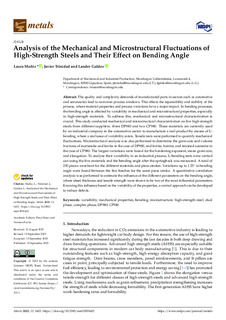Izenburua
Analysis of the mechanical and microstructural fluctuations of high-strength steels and their effect on bending angleBertsioa
Bertsio argitaratua
Eskubideak
© 2023 The AuthorsSarbidea
Sarbide irekiaArgitaratzailearen bertsioa
https://doi.org/10.3390/met13091603Non argitaratua
Metals Vol. 13. N. 9. N. art. 1603, 2023Argitaratzailea
MDPIGako-hitzak
Variability
mechanical properties
Bending
microstructure ... [+]
mechanical properties
Bending
microstructure ... [+]
Variability
mechanical properties
Bending
microstructure
high-strength steel
dual phase
complex phase
DP980
CP980 [-]
mechanical properties
Bending
microstructure
high-strength steel
dual phase
complex phase
DP980
CP980 [-]
Eremua (UNESCO Sailkapena)
Zientzia TeknologikoakDiziplina (UNESCO Sailkapena)
Materialen teknologiaLaburpena
The quality and complexity demands of manufactured parts in sectors such as automotive and aeronautics lead to narrower process windows. This affects the repeatability and stability of the process, wh ... [+]
The quality and complexity demands of manufactured parts in sectors such as automotive and aeronautics lead to narrower process windows. This affects the repeatability and stability of the process, where material properties and process variations have a major impact. In bending processes, the bending angle is affected by variability in mechanical and microstructural properties, especially in high-strength materials. To address this, mechanical and microstructural characterization is crucial. This study conducted mechanical and microstructural characterization on five high-strength steels from different suppliers: three DP980 and two CP980. These materials are currently used by an industrial company in the automotive sector to manufacture a real product by means of U-bending, where a real issue of variability exists. Tensile tests were performed to quantify mechanical fluctuations. Microstructural analysis was also performed to determine the grain size and volume fractions of martensite and ferrite in the case of DP980, and ferrite, bainite, and retained austenite in the case of CP980. The largest variations were found for the hardening exponent, mean grain size, and elongation. To analyze their variability in an industrial process, U-bending tests were carried out using the five materials and the bending angle after the springback was measured. A total of 250 pieces were bent for the different materials and press strokes. Variations up to 1.25° in bending angle were found between the five batches for the same press stroke. A quantitative correlation analysis was performed to estimate the influence of the different parameters on the bending angle, where sheet thickness and tensile strength were shown to be two of the most influential parameters. Knowing this influence based on the variability of the properties, a control approach can be developed to reduce defects. [-]
Finantzatzailea
Comisión EuropeaPrograma
RFCSZenbakia
RFCS-2018-800730Laguntzaren URIa
Sin informaciónProiektua
DP1000 steel press bending holistic process chain improvement by novel control techniques and through thickness residual stress tailoring (FLATBEND)Bildumak
Item honek honako baimen-fitxategi hauek dauzka asoziatuta:






















